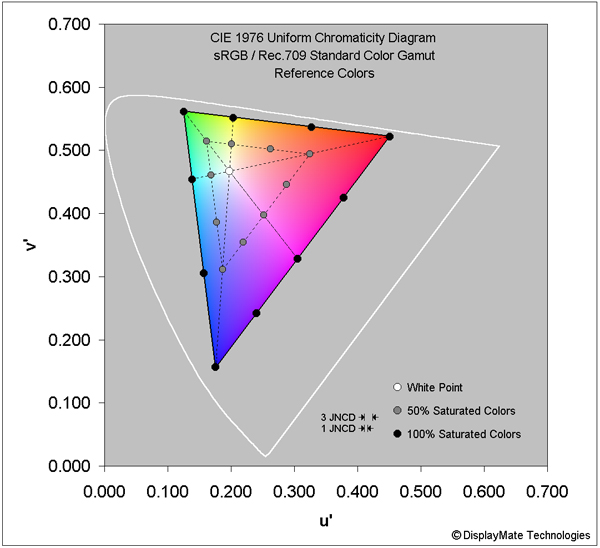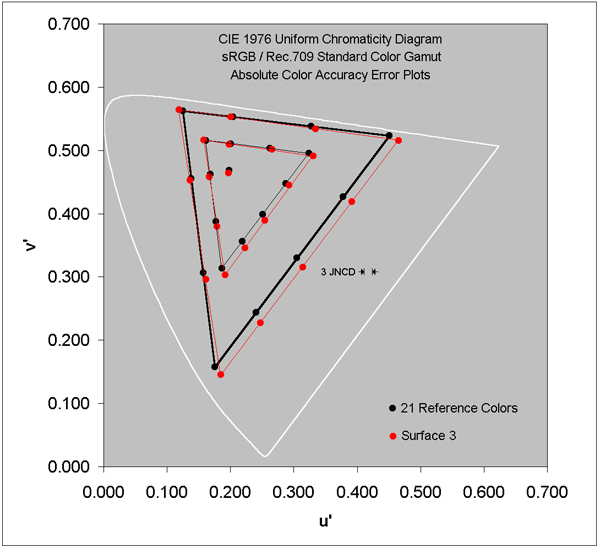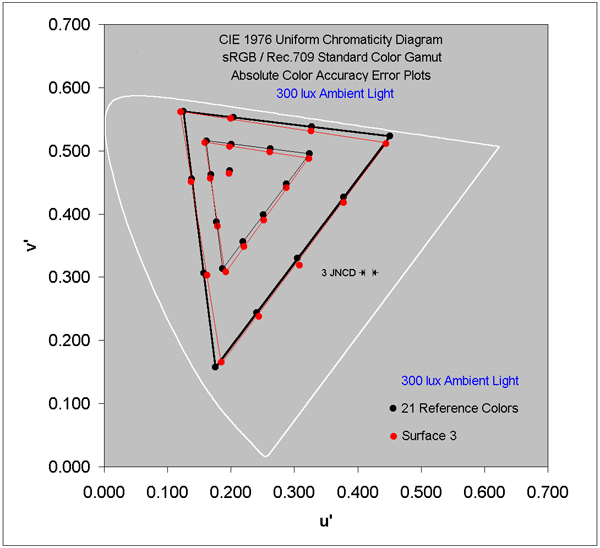Reference sRGB / Rec.709 Colors
Virtually all current consumer content
is based on the sRGB / Rec.709 Color Gamut Standard.
Figure 2a
below shows 21 Reference Colors for the
Standard sRGB / Rec.709 Color Gamut as White, Gray, and Black circles,
The 10 Black circles are the 100 percent fully saturated colors on the periphery
of the Gamut triangle.
The 10 Gray circles are the 50 percent saturated colors that are exactly midway
between the White Point and the 100 percent saturated colors on the periphery.
The White circle is the White Point with zero percent color saturation.
The colors in
Figure 2a
have been accurately calculated to show the real colors
within the sRGB / Rec.709 Gamut - the colors shown in most published
Color Gamuts are wildly incorrect.
Uniform Color Diagrams
All color measurements are plotted on 1976 CIE Uniform Color Diagrams.
Note that the older 1931 CIE Diagrams that are published by many reviewers
are highly non-uniform and are meaningless for Color Accuracy.
Also the often referenced NTSC Color Gamut is from 1953 and has been
obsolete for over 30 years so stop referencing it.
Absolute Color Accuracy Plots
Figure 2b
below shows the measured on-screen colors of the Reference Colors
in 0 lux Absolute Darkness.
Figure 2c
below shows the measured on-screen colors of the Reference Colors
in 300 lux Ambient Light.
Reference Colors
The
Reference Colors
in
Figures 2b-2c
are all shown as Black circles and the measured
Colors for each of the 0 lux and 300 lux Ambient Light levels
are shown as Red circles.
Color Errors smaller than the appropriate JNCD are not visually noticeable.
The 1 JNCD and 3 JNCD Errors are discussed next and are shown in the Figures below.
Just Noticeable Color Difference JNCD
The on-screen colors produced by any display can be measured using a
Spectroradiometer together with our DisplayMate Test Patterns.
The accuracy of the colors can then be calculated using the
1976 CIE Uniform Chromaticity color space and compared to the
eye's sensitivity to color.
We present the color accuracy and errors here in terms of
MPCD Minimum Perceptible Color Difference or
JNCD Just Noticeable Color Difference,
where 1 MPCD = 1 JNCD = Δ(u'v') = 0.0040 on the
CIE 1976 Uniform Chromaticity Scale.
Color differences less than 1 JNCD are visually indistinguishable, while values greater than 1 JNCD are visually noticeable when the two colors are touching on-screen. When the colors are not touching and are further apart, the visual threshold for Just Noticing a Color Difference is higher. Here we will use 3 JNCD for the threshold of a visually noticeable display color difference. The 1 JNCD and 3 JNCD sizes are shown in the Figures below. Any Display Color Error less than 3 JNCD on a display is not visually noticeable and appears perfectly accurate to the eye.
Note that Complementary Colors lie directly across from one another through the White Point.
The 50% Saturated Colors are midway between White and the 100% Saturated Colors.

The colors in Figure 2a have been accurately calculated to show the real colors within the sRGB / Rec.709 Gamut.
The colors shown in most published Color Gamuts are wildly incorrect.
Figure 2b. Absolute Color Accuracy Plot for 0 lux Ambient Light
0 lux ambient light corresponds to absolute darkness.

Figure 2c. Absolute Color Accuracy Plot for 300 lux Ambient Light
300 lux corresponds to typical workspace indoor ambient lighting levels.
